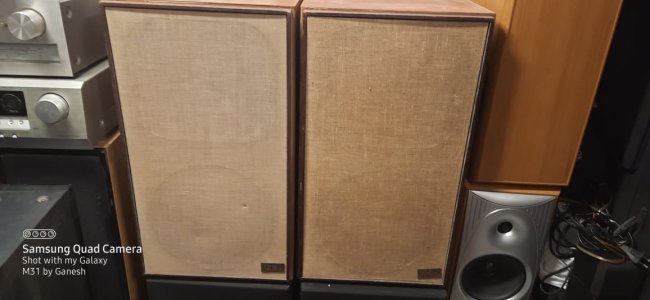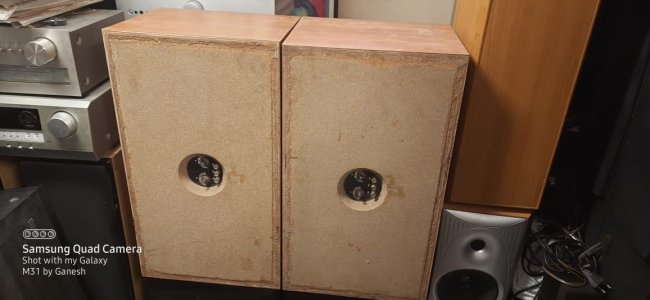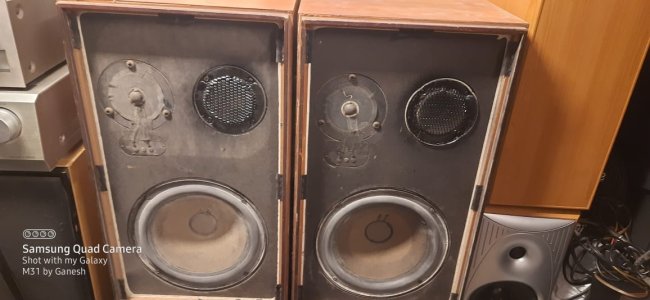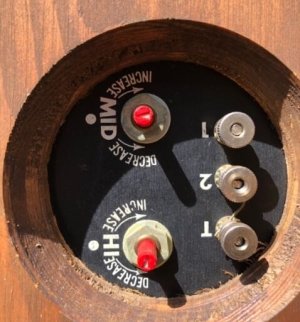As I mentioned earlier, the controls are L-Pads, not pots. The roughness you feel when you rotate them is because the wiper runs across tightly wound wires, not along a carbon track like a typical pot. One control is for mids and one for the tweeters. The three things you see in a row are the connectors. The connectors are labelled 1, 2 and T.
Connector 1 goes to the amp output labelled 0, Neg, Black, or whatever your amp has. Connector 2 goes to the 8 ohm, Pos, or Red.
To run them full range a wire jumper is used to connect Connector 2 and T. Without the jumper the tweeter and perhaps even the midrange driver is disconnected. This allows you to run the woofer only, if you wish.
Here's a close up pic of the back taken from the web. You can see the wire jumper between terminal 2 and T.
View attachment 78200
As I said, I'm not an expert on all the variations of AR speakers but I've seen some that use a cloth surround on the woofer and others that use foam. If yours has foam it is likely that it's fragile or perhaps even deteriorated to the point that it may come apart when you play it or even touch it. Of course replacement foam is available and if yours is in good shape then someone must have already replaced it at some point. The material used in the original foam on these and other brands (Advents etc) contains an acid which cause the foam to break down eventually. None of the original surrounds will have survived this long. Replacing the foam is not very difficult, I've replaced foam on a few Advents.
If yours have foam, I would suggest you only play them at very low volume at first to see how they stand up.
The ones with the cloth surrounds usually benefit from having some type of pliable sealant applied to the cloth. That's because the original sealant can deteriorate and the air can seep through it. The speakers are designed to be totally sealed and, while they can be used safely with a less than perfect seal, bass response will be much better when they're sealed.
While I don't recall replacing any of the crossover caps in mine, and they do still work reasonably well, I'm sure that rebuilding the crossovers would improve them, perhaps a lot. Any decent quality film cap with the same specs as stock should be fine. I'm not sure what the original caps were though. If they were film then they might still measure fine. If they're electrolytics then you should replace them with films.
Here's a description of the speakers I found online:
The Acoustic Research 2x and 2ax (AR-2x / AR-2ax) are based on the design of the AR-3a, but were marketed as a value product, which means price played a crucial role. Therefore it contains most of the typical elements and ingredients as the high-priced Acoustic Research speakers, but has a slightly lower performance.
AR-2x / AR-2ax Differences:
The AR-2ax is a 3-way acoustic suspension speaker, meaning that its cabinets are completely sealed. The AR-2x is a 2-way acoustic suspension speaker which does not have the 1 3/8 in dome-type super-tweeter of the AR-2ax. According to a press comment, prices in 1971 for these speakers were similar, with the AR-2x being sold for $102 (in walnut) and the AR-2ax being sold at a slightly higher price for $128 (in walnut). The speakers were also available in different cabinets, priced at $89 / $109 for unfinished pine cabinets or $96 / $122 for mahogany/ birch cabinets. However, it seems that different sources have very different prices, not at last because the speakers have been sold for many years and prices decreased over time. As you can see at the Acoustic Research ad above, the AR 2Aax has also been sold for $139.
“The AR-2ax is a lower-cost version of our basic acoustic suspension design. It contains the 254mm woofer and 19 mm hemispherical dome, for very high frequencies, used in the AR-5. The midrange is covered by an 89 mm wide-dispersion cone unit. Separate controls on the back of the AR-2ax permit independent adjustment of the level of the midrange and high-frequency speakers.” (1960/70ies Acoustic Research brochure)
Refoaming the AR-2x and AR-2ax
The AR-2 are fabulous speakers and restoring a broken or worn down pair can really pay off. Many of the ARs have foam surrounds that rotted away over the years. Frequently sellers will give them away for very little money, as these speakers were at the lower end of the price range of Acoustic Research models. A refoaming kit can usually be bought for around $30. Replacing the old foams will take around 1 to 2 hours and is not difficult at all! It does not require any particular skill, just a calm hand and a little patience. We tried out several different available foams and recommend to use Parts Express´ 10 inch Surround Kit.

AR-2x and AR-2ax Speaker
Both, AR-2x and AR-2ax share the following specifications (except the 1 3/8″ tweeter):
Drive units: 10 in acoustic suspension woofer, 3 ½ in midrange cone,1 3/8 in mm high frequency hemispherical dome
Crossover: 1400 Hz, 5000 Hz
Impedance: 8 Ohms nominal
Controls: Midrange and high-frequency driver level controls
Amplifier: Up to 100 watts per channel
Size: 13.5 x 24 x 11.5 in
Weight: 36.5 lbs
Woofer resonance: Free air 26 Hz, in enclosure 56 Hz
Volume of enclosure: 38.2 litres (1.35 cu ft)





